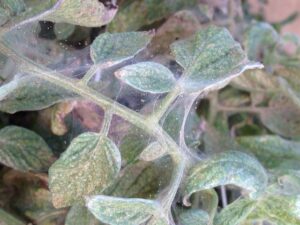Sweet Corn
Fall armyworm (FAW) infestations in whorl stage plantings remain a presence. In scouted fields, some infestations in whorl corn are in excess of 20%, and are likely much higher in the southern coastal areas. Growers are advised to check whorl and seedling stage corn plantings weekly for signs of FAW. Consider treating if infestation rates exceed 10%. This pest is capable of significant injury to sweet corn plants, resulting in severe stunting and failure to produce viable ears. Note that growers of Attribute II type genetically engineered corn are unlikely to see damage from FAW.
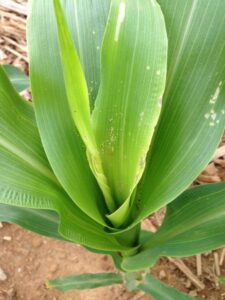
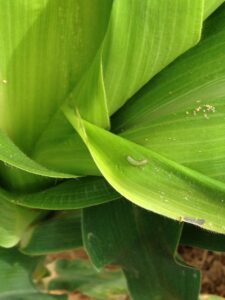 Newly hatched FAW larvae cause holes and scratches on leaves that are similar to European corn borer (ECB) feeding, except that they tend to be more concentrated and always lead down into the whorl (see photos at left). As the larvae grow, the feeding becomes more destructive, with large ragged holes and obvious droppings deposited in the whorl (see photo at right).
Newly hatched FAW larvae cause holes and scratches on leaves that are similar to European corn borer (ECB) feeding, except that they tend to be more concentrated and always lead down into the whorl (see photos at left). As the larvae grow, the feeding becomes more destructive, with large ragged holes and obvious droppings deposited in the whorl (see photo at right). 
We will provide updates on new FAW appearances and severity as reports come in. FAW are resistant to synthetic pyrethroids. Effective sprays should include IRAC grp. 5 (spinosyns) or IRAC grp. 28 (diamides). The carbamate (IRAC grp. 1A) Lannate is also still effective. Sufficient water should be used in the applications to allow the solution to penetrate the layer of droppings that may have formed above the caterpillar.
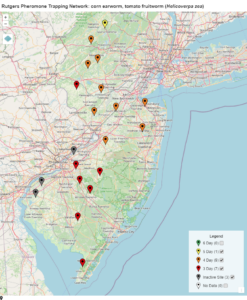 Corn earworm (CEW) moths captures from northern and central blacklight traps have increased significantly in many of these areas. Pheromone trap information is available from all northern and central sites, with input from southern New Jersey. We will use a combination of pheromone and blacklight trap types to derive silk spray schedules by region. The CEW numbers from reporting pheromone traps have increased again in all parts of the state, although a few individual traps are lower. Highest activity continues to be in central South Jersey (see map at right), although high catches extend northward into Hunterdon County. Growers should anticipate population spikes during periods of very warm humid weather preceding frontal storm systems. Cool evening temperatures and northwest winds that often follow frontal systems may depress activity temporarily. Silking corn is at significant risk of CEW infestation at this time. Green areas on the map correspond to a 4-5 day schedule, while red corresponds to a 3-day spray schedule. Be sure to access information from this publication in the upcoming weeks to determine how frequently you should treat silking sweet corn to protect it from CEW infestation.
Corn earworm (CEW) moths captures from northern and central blacklight traps have increased significantly in many of these areas. Pheromone trap information is available from all northern and central sites, with input from southern New Jersey. We will use a combination of pheromone and blacklight trap types to derive silk spray schedules by region. The CEW numbers from reporting pheromone traps have increased again in all parts of the state, although a few individual traps are lower. Highest activity continues to be in central South Jersey (see map at right), although high catches extend northward into Hunterdon County. Growers should anticipate population spikes during periods of very warm humid weather preceding frontal storm systems. Cool evening temperatures and northwest winds that often follow frontal systems may depress activity temporarily. Silking corn is at significant risk of CEW infestation at this time. Green areas on the map correspond to a 4-5 day schedule, while red corresponds to a 3-day spray schedule. Be sure to access information from this publication in the upcoming weeks to determine how frequently you should treat silking sweet corn to protect it from CEW infestation.
The highest nightly blacklight trap catches of CEW (north and central counties) for the week ending 8/16/23 are as follows:
| Allentown 4 | Dayton 3 | Hackettstown 1 |
| Farmingdale 4 | Matawan 3 | Hillsborough 1 |
| Georgetown 4 | Morristown 2 | Milltown 1 |
| New Egypt 4 | Denville 1 | Princeton 1 |
The highest nightly pheromone trap catches of CEW for the week ending 8/16/23 are as follows:
| Tabernacle 193 | Snyder Farm (Hunterdon) 37 | Pennington 15 |
| Elm 66 | Green Creek 35 | Chester 10 |
| East Vineland 63 | Berlin 32 | Dayton 9 |
| Springdale 40 | Georgetown 16 | Califon 8 |
Silking Spray Schedules*:
South – 3 days
Central – 3 days
North – 3-4 days
*These recommendations are based on regional catches. Adhere to tighter spray schedules if indicated by local trap catches. Synthetic pyrethroids alone should NOT be used for corn earworm (CEW) protection on silking corn, or for fall armyworm (FAW) management at any stage. Control with these materials is very inconsistent.
Sap Beetles
Growers experiencing problems with sap beetles during harvest should consider adding the active ingredient acetamiprid in 1-2 silk applications along with the CEW targeted materials. This IRAC group 4A material (Assail, Anarchy) will not control CEW, but is useful for sap beetles and corn leaf aphids. Hot days and warm nights favor sap beetle infestations, particularly when corn ears grow to the end of the husks, enabling easy entry for the beetles.
Tomatoes
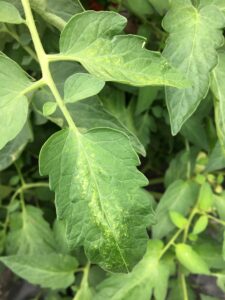 Two-spotted spider mites (TSSM) are being found in nearly every scouted tomato field at this time. This is particularly evident where preferred hosts like eggplant are in adjacent fields. Initial, low-level infestations result in a mite “stipple” on the upper leaf surface (see photo at right). In these cases several mites may be found on the lower leaf surface. With hot, dry conditions and no control applied, mites multiply rapidly. A large population will create webbing that can cover entire plant leaves and branches (see photo below). Large populations can become quite difficult to manage, so treatment should be applied upon finding a mite infestation at any level. This can limit future problems with this pest. There are a number of effective miticides listed in the Tomato Section from the 2022-23 Guide.
Two-spotted spider mites (TSSM) are being found in nearly every scouted tomato field at this time. This is particularly evident where preferred hosts like eggplant are in adjacent fields. Initial, low-level infestations result in a mite “stipple” on the upper leaf surface (see photo at right). In these cases several mites may be found on the lower leaf surface. With hot, dry conditions and no control applied, mites multiply rapidly. A large population will create webbing that can cover entire plant leaves and branches (see photo below). Large populations can become quite difficult to manage, so treatment should be applied upon finding a mite infestation at any level. This can limit future problems with this pest. There are a number of effective miticides listed in the Tomato Section from the 2022-23 Guide.
Cucurbit Downy Mildew
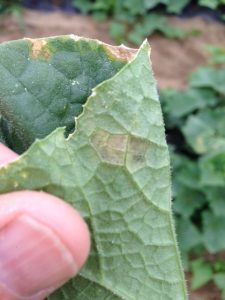
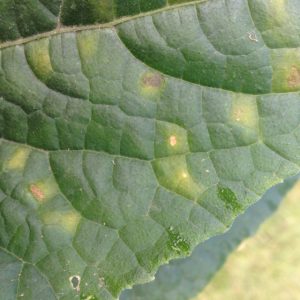 Cucurbit downy mildew is impacting cucumbers in all parts of New Jersey at this time, and limited cantaloupe infections in southern NJ have been reported. All cucumber and cantaloupe plantings should be protected. Useful materials for CDM may be found in the Cucumber Section of the 2022/23 Commercial Vegetable Production Recommendations. A sentinel plot is established at Snyder Farm in Hunterdon County, consisting of pumpkin, watermelon, cantaloupe, butternut, acorn, cucumber and kabocha squash will be used to indicate the presence of cucurbit downy mildew in the region, and what crops are affected. As of 7/21/23, CDM was detected on cucumbers in this plot in Hunterdon County. For regional information on this important disease, see the Cucurbit Downy Mildew webpage: http://cdm.ipmpipe.org/. Note that the forecast component of this site is not active this season. However, reports of CDM can still be reported on the site, and may appear on the homepage map down to county level with associated host information. It appears that fewer incidents of CDM are being reported on the site than would be expected. Therefore, it is critical that growers subscribe to the Vegetable Crops edition of the Plant and Pest Advisory in order to receive the most current information on outbreaks from Dr. Andy Wyenandt. Heavy rains favor arrival and spread of this disease. All growers should be checking potential host crops at least once a week for signs of infection. Symptoms on the upper leaf surface are yellow lesions bordered by leaf veins (upper right photo), while on the lower surface, dark sporulation may be found (upper left photo).
Cucurbit downy mildew is impacting cucumbers in all parts of New Jersey at this time, and limited cantaloupe infections in southern NJ have been reported. All cucumber and cantaloupe plantings should be protected. Useful materials for CDM may be found in the Cucumber Section of the 2022/23 Commercial Vegetable Production Recommendations. A sentinel plot is established at Snyder Farm in Hunterdon County, consisting of pumpkin, watermelon, cantaloupe, butternut, acorn, cucumber and kabocha squash will be used to indicate the presence of cucurbit downy mildew in the region, and what crops are affected. As of 7/21/23, CDM was detected on cucumbers in this plot in Hunterdon County. For regional information on this important disease, see the Cucurbit Downy Mildew webpage: http://cdm.ipmpipe.org/. Note that the forecast component of this site is not active this season. However, reports of CDM can still be reported on the site, and may appear on the homepage map down to county level with associated host information. It appears that fewer incidents of CDM are being reported on the site than would be expected. Therefore, it is critical that growers subscribe to the Vegetable Crops edition of the Plant and Pest Advisory in order to receive the most current information on outbreaks from Dr. Andy Wyenandt. Heavy rains favor arrival and spread of this disease. All growers should be checking potential host crops at least once a week for signs of infection. Symptoms on the upper leaf surface are yellow lesions bordered by leaf veins (upper right photo), while on the lower surface, dark sporulation may be found (upper left photo).
Pumpkins and Winter Squash
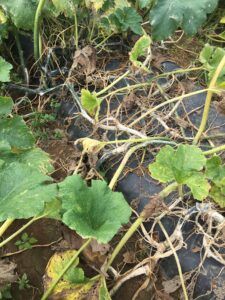
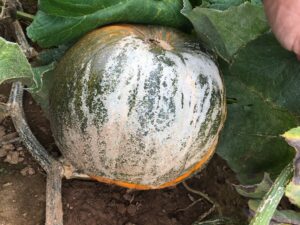 With heavy rain events, pumpkin growers should be alert to the possibility of plectosporium blight (see photos at left) impacting plantings prior to the onset of powdery mildew (PM) sprays. The powdery mildew spray schedule is triggered by the appearance of 2 or more PM lesions per 50 mature leaves in a 50 plant sample. Protectant fungicides used in the PM program are useful in limiting plectosporium blight, but if the organism is present in field soil, and wet conditions prevail, it can become a problem prior to initiation of the PM spray schedule. Plectosporium infection results in numerous dry, white lesions on the surface of vines, petioles and fruit. Infected vines become brittle when heavily infected. See Dr. Andy Wyenandt’s post of 7/13 on managing plectosporium blight.
With heavy rain events, pumpkin growers should be alert to the possibility of plectosporium blight (see photos at left) impacting plantings prior to the onset of powdery mildew (PM) sprays. The powdery mildew spray schedule is triggered by the appearance of 2 or more PM lesions per 50 mature leaves in a 50 plant sample. Protectant fungicides used in the PM program are useful in limiting plectosporium blight, but if the organism is present in field soil, and wet conditions prevail, it can become a problem prior to initiation of the PM spray schedule. Plectosporium infection results in numerous dry, white lesions on the surface of vines, petioles and fruit. Infected vines become brittle when heavily infected. See Dr. Andy Wyenandt’s post of 7/13 on managing plectosporium blight.
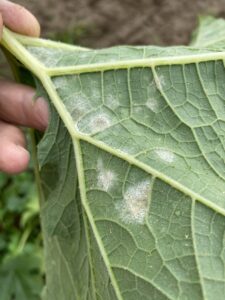 Powdery mildew (PM) thresholds (2 infected leaves/50 leaf sample) have been reached in all scouted plantings. Once PM lesions (photo at right) begin to appear, the fungicide program for this disease should be initiated. The program generally includes a combination of broad spectrum protectants and more targeted, locally systemic fungicides. Try to select 2-3 systemics with different FRAC codes for a solid rotation to avoid development of resistance to the fungicides. For a complete list of suggested materials, see the Pumpkin and Winter Squash Section of the 2022/23 Commercial Vegetable Production Recommendations.
Powdery mildew (PM) thresholds (2 infected leaves/50 leaf sample) have been reached in all scouted plantings. Once PM lesions (photo at right) begin to appear, the fungicide program for this disease should be initiated. The program generally includes a combination of broad spectrum protectants and more targeted, locally systemic fungicides. Try to select 2-3 systemics with different FRAC codes for a solid rotation to avoid development of resistance to the fungicides. For a complete list of suggested materials, see the Pumpkin and Winter Squash Section of the 2022/23 Commercial Vegetable Production Recommendations.
